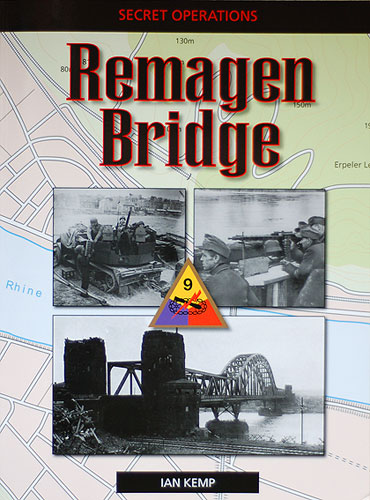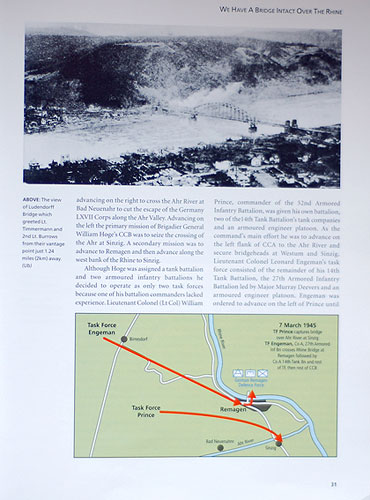|
|
|
|
Secret Operations – Remagen Bridge
by Ian Kemp
Reviewed by Adam O’Brien

Summary
| Publisher and Title | Secret Operations – Remagen Bridge by Ian Kemp |
| ISBN: | 0 7110 3095 2 |
| Media and Contents: | Soft cover, A4 format, 96 pages colour & b/w |
| Price: | £16.99 available online from Ian Allan Publishing |
| Review Type: | First Read |
| Advantages: | Well written, easy to follow with nice photography and illustrations. |
| Disadvantages: | |
| Recommendation: | Recommended |
FirstRead
The Ludendorff Bridge was built during the First World War.
Constructed to move troops and equipment over the Rhine to reinforce
the Western Front. On the 7th March 1945, soldiers from the 27th
Armoured Infantry Battalion approached the Rhine to find this bridge
at Remagen the only one left standing. The German soldiers stationed
there had intentionally left the bridge intact, defying orders to do
so. The capture of the bridge is referred to in U.S history as the
“Miracle of Remagen” and General Walter Smith had said that “the
bridge is worth its weight in gold”. The capture of the bridge
allowed small U.S formations to operate east of the Rhine ahead of
the main crossings under Patton and Montgomery.
 In
the days following the capture of the bridge, the German High
Command made several desperate attempts to destroy it. They
succeeded in irreversibly damaging it, but due the the quick
construction of pontoon bridge by the U.S. engineers at the site,
the final collapse of the Ludendorff Bridge was neither tactically
nor strategically significant.
In
the days following the capture of the bridge, the German High
Command made several desperate attempts to destroy it. They
succeeded in irreversibly damaging it, but due the the quick
construction of pontoon bridge by the U.S. engineers at the site,
the final collapse of the Ludendorff Bridge was neither tactically
nor strategically significant.
Like the previously reviewed book
in the series, “Pointe du Hoc”, I found it very easy to follow and
enjoyable to read, again, similar to a TV documentary in book form.
Chapter one details the Ludendorff Bridge and its history, nicely
illustrated with a series of period photos and lithos. As part of
this chapter we also have a couple of excellent photos of the German
defences of the bridge, including the 3.7cm & 2cm flak guns – superb
reference for a small vignette?
Next up in Chapter Two, the Allied plans of the Rhine crossings are
put together. Details of the different divisions and battalions are
listed, as are full-page profiles of the U.S commanders involved in
the operation. Within this chapter we have detailed descriptions and
data on both the M4A3 Sherman and the M26 Pershing tanks. Of special
interest here is a nice photo and description of an M26 moving
across the Rhine on a makeshift pontoon, powered by 5 outboard
motors! again, a great diorama possibility.
The next 2 chapters detail the actual bridge crossing by the U.S.
forces to establish a bridgehead on the eastern bank of the Rhine.
Beautifully illustrated with full colour maps and b/w photography,
we have a concise description of the operation. I found these
chapters a very interesting read.
The longest section of the book is a chapter titled “Consolidation”.
Once the bridgehead had been established, the U.S forces went about
consolidating their position and securing the eastern bank of the
Rhine. Meanwhile, Hitler was searching for scapegoats, needless to
say, heads did roll…
In this section of the book we have
a good series of b/w photos of the U.S. engineers in action, with
some excellent photos of the pontoon bridge under construction. On
the German side, there are small sections detailing the PzKpfw V
Panther, the 60cm Morser Karl and the Arado Ar234B-2 bomber. To
finish the chapter, there is a nice 2-page colour spread on the V-2
missile, 11 of which were launched in the German attack on Remagen.
The final chapter details the inevitable collapse of the Ludendorff
bridge, due to the damage it received both during and after the
operation. Light in text but profusely illustrated with superb b/w
photos of the collapsed structure ( including one in colour). The
book’s last page is a fitting tribute to the Allied engineers, who
constructed over 100 assault bridges over the Rhine.
Conclusion
I found “Secret Operations –
Remagen Bridge” an excellent description of the events at Remagen in
the spring of 1945. The book has a very sturdy binding (more so than
a lot of other softcover books) and is brilliantly illustrated
throughout with colour and b/w photography and well-drawn maps. In
addition, it is great inspiration for diorama builders.
Recommended.
Thanks to Specialty Press for the review sample
